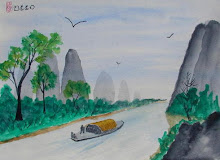How quickly we forget. We must remember the Russians are good chess players. Years ago during the "Cold War" the USA put Jupiter C missiles in Turkey. Naturally the Soviets didn't think that was a friendly gesture. So, being great chess players the USSR put missiles in Cuba and said "CHECK!! "
The USA got all excited about the missiles in Cuba but did not inform the American public that we had missiles in Turkey. The entire Stratigic Air Command loaded nuclear weapons and was on the ready before President Kennedy made his public speach announcing the USSR missiles being in Cuba.
The American public was lead to believe the USSR backed down and removed their missiles.
NOT TRUE!! The USA and the USSR made an agreement. The USA would remove its missiles from Turkey and the USSR would remove theirs from Cuba.
Now the USA is about to start a similar situation. Will we wise up and save the world, or will we see Doom's Day?
The USA is going to put "defensive" missiles in Poland and the Czech Republic. Russia doesn't think this is a friendly move. What will Russia do before they say "CHECK" next time?
Saturday, April 5, 2008
Friday, April 4, 2008
Good Bye Pus Pus

026+(2).jpg)
.jpg)
019JPG.jpg)
Puss Puss was found in a rental truck. It was her cries that attracted attention. A Manx cat with an interesting face lived for twenty years. One day her mistress was going on a trip. Puss Puss climbed into the suitcase and settled down as to say "I'm going too." One day a chill wind blew and Puss Puss was taken away taking a piece of our hearts with her.
Two of Puss Puss's residential friends miss her: Thai and Pussy Cat.
Monday, March 31, 2008
Li River, China
The karst topography of the Li River Valley in the Guilin area of China is one of the most scenic areas of the world. This watercolor is a mythical painting from my mind.
The mountains of this area remind me of French bread standing on end.
The mountains of this area remind me of French bread standing on end.
Monday, March 17, 2008
Walla Walla Branch of the Oregon Trail
Sunday, March 16, 2008
A Great Experience
Some years ago while I was in my work area in the Division of Invertebrate Paleontology in the Natural History Building of the United States National Museum, Smithsonian Institution I was working with some fossil echinoids when a stranger came into my room. He intrduced himself as Louis Leakey and asked if he could visit with me for awhile. I offered him a chair and said I would be happy to visit with him.
I must say I was very startled to realize I was to have a one-on-one visit with this renowned anthropologist. After exchanging small talk for a few minutes I learned why Dr. Leakey had come to the Division of Invertibrate Paleontology instead of going to the Department of Anthropology. Dr. Leakey was not looking for someone to discuss fossil hominids, but rather to show a very unusual invertebrate fossil he found.
Reaching into his pocket and slowly withdrawing his closed fist he reached toward me and slowly opened his hand. I was amazed at the sight of a fossil rare indeed. It was a silicon dioxide perfect caterpillar without hair. A caterpillar is an animal composed of entirely soft parts. It is vary rare for such animals to be preserved as fossils especilly as three dimensional specimens. The Cambrian Burgess Shale contains soft body fossils but they are just a thin film on the rock.
I speculate this caterpillar must have been trapped in a mud deposit that turned to rock. As ground water slowly removed the organic material silicon dioxide gradually filled the cavity left by the caterpillar. After the erosion of the rock the caterpillar lay on the ground and Dr. Leakey found it. Even the little ambulatory appendages were visible on the abdominal surface.
Dr. Leakey and I sat for about an hour discussing fossils before he decided he had to leave.
I must say I was very startled to realize I was to have a one-on-one visit with this renowned anthropologist. After exchanging small talk for a few minutes I learned why Dr. Leakey had come to the Division of Invertibrate Paleontology instead of going to the Department of Anthropology. Dr. Leakey was not looking for someone to discuss fossil hominids, but rather to show a very unusual invertebrate fossil he found.
Reaching into his pocket and slowly withdrawing his closed fist he reached toward me and slowly opened his hand. I was amazed at the sight of a fossil rare indeed. It was a silicon dioxide perfect caterpillar without hair. A caterpillar is an animal composed of entirely soft parts. It is vary rare for such animals to be preserved as fossils especilly as three dimensional specimens. The Cambrian Burgess Shale contains soft body fossils but they are just a thin film on the rock.
I speculate this caterpillar must have been trapped in a mud deposit that turned to rock. As ground water slowly removed the organic material silicon dioxide gradually filled the cavity left by the caterpillar. After the erosion of the rock the caterpillar lay on the ground and Dr. Leakey found it. Even the little ambulatory appendages were visible on the abdominal surface.
Dr. Leakey and I sat for about an hour discussing fossils before he decided he had to leave.
Subscribe to:
Comments (Atom)


.jpg)








.jpg)
